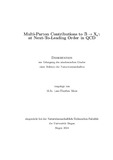Citation link:
http://dx.doi.org/10.25819/ubsi/10605Files in This Item:
| File | Description | Size | Format | |
|---|---|---|---|---|
| Dissertation_Moos_Lars-Thorben.pdf | 1.44 MB | Adobe PDF |  View/Open |
| Dokument Type: | Doctoral Thesis | metadata.dc.title: | Multi-Parton Contributions to B̄ → Xs γ at Next-To-Leading Order in QCD | Other Titles: | Multi-Parton Beiträge zu B̄ → Xs γ in Nächst-Zu-Führender Ordnung in QCD | Authors: | Moos, Lars-Thorben | Institute: | Center for Particle Physics | Free keywords: | Flavor physics, Loop calculations, Flavour-Physik, Schleifenberechnungen | Dewey Decimal Classification: | 530 Physik | GHBS-Clases: | UHXE UHXQ UHXD |
Issue Date: | 2024 | Publish Date: | 2024 | Abstract: | The calculation of the branching ratio for the inclusive decay B̄ → Xs γ has been an active field of research for multiple decades, yielding results that work very well as a standard candle of the Standard Model of Particle Physics (SM). The large interest in this observable has already led to an almost complete expression for the next- to-leading order (NLO) part and a large number of next-to-next-to-leading order (NNLO) contributions to the theoretical prediction. With results from colliders becoming ever more precise, the need for higher precision of theoretical predictions arises. In this work, we calculate the remaining pieces for the branching ratio of the four- body decay of a b quark into an s quark, a photon γ and two additional quarks qq̄ at NLO in the strong coupling αs . The calculation of this one-loop process b → sγqq̄, which includes a virtual gluon, has to be supplemented by b → sγqq̄g, since the loop calculation results in infrared divergences that have to be cancelled by the real- emission counterparts. One focus of this thesis is the computation of the occurring four- and five-body phase space integrals and the calculational techniques that are crucial in obtaining them. These include the latest iterations of integration-by-parts (IBP) methods that we used to obtain our sets of master integrals and a description of the differential equations we used to solve them. We further lay out the different methods we used to determine the necessary boundary conditions for these, tailored to the different challenges we encountered. Furthermore we describe our methods of renormalization and regularization. We are using dimensional regularization throughout this work and, in this framework, treating the final state quarks massless leads to residual collinear divergences. For these remaining divergent expressions, we employ splitting-function regularization to switch the regularization scheme from dimensional regularization to logarithms of the quark masses. We also give an overview over the ongoing effort in the calculation of the last missing piece for the future completion of the perturbative contributions at O(αs ) which is tied to the next-to-leading order splitting function. Using these techniques, we calculate the analytic results for our correction to the decay width of B̄ → Xs γ as one of the missing pieces for the NLO branching fraction. The expressions are made publicly available online in Mathematica format for further use. Finally, we discuss future steps for obtaining a numerical result. Das Verzweigungsverhältnis des inklusiven Zerfalls B̄ → Xs γ ist seit mehreren Jahrzehnten ein sehr aktives Feld der Teilchenphysik und funktioniert durch hohe theoretische und experimentelle Genauigkeit als eine Standardkerze für das Stan- dardmodell der Teilchenphysik (SM). Durch das hohe Interesse an einer genauen theoretischen Vorhersage liegen heutzutage eine fast vollständige Berechnung auf nächst-zu-führender Ordnung und eine hohe Anzahl an Beiträgen auf nächst-zu- nächst-zu-führender Ordnung vor. Die stetig steigende Präzision von Messungen an Beschleunigern ruft auch nach einer steigenden Präzision der theoretischen Vorher- sagen. In der vorliegenden Arbeit berechnen wir die verbleibenden Beiträge von Vier- Körper-Zerfällen eines b-Quark in ein s-Quark, ein Photon γ und zwei zusätzliche Quarks qq̄ zum Verzweigungsverhältnis in nächst-zu-führender Ordnung in der star- ken Kopplung αs. Dieser Ein-Schleifen-Prozess b → sγqq̄, der ein virtuelles Gluon g beinhaltet, muss durch den entsprechenden reellen Abstrahlungsprozess b → sγqq̄g ergänzt werden, um durch das Gluon hervorgerufenene Infrarot-Divergenzen zu eli- minieren. Ein Fokus dieser Arbeit liegt auf der Berechnung der auftretenden Vier- und Fünf- Teilchen Phasenraum-Integrale und den dafür benötigten Rechentechniken. Diese beinhalten aktuelle Methoden der Reduktion durch partielle Integration (IBP) mit denen wir jeweils unsere Basis an Masterintegralen identifiziert haben. Zudem be- schreiben wir die Lösung dieser Masterintegrale mithilfe von Differentialgleichungen und die verschiedenen Arten, auf die wir die hierfür benötigten Randbedingungen bestimmt haben. Weiterhin legen wir unsere Methodik für Renormierung und Regularisierung dar. Da wir die Quarks im Endzustand als masselos behandeln, führt unsere Nutzung von dimensionaler Regularisierung zu verbleibenden kollinearen Divergenzen. Für diese verbleibenden, divergenten Ausdrücke wechseln wir das Regularisierungssche- ma mittels Splitting-Funktionen und tauschen die verbleibenden Pole gegen einen natürlicheren Regulator, d.h. Logarithmen der Quark-Massen, ein. Dabei geben wir einen Überblick über die momentan noch laufende Berechnung des letzten Teils der Splitting-Funktion auf nächst-zu-führender Ordnung, der für eine Vervollständigung der perturbativen Beiträge auf O(αs ) in Zukunft benötigt wird. Unter Nutzung dieser Techniken geben wir hier analytische Ergebnisse für unse- ren Beitrag zur Zerfallsbreite von B̄ → Xsγ als einen der letzten fehlenden Teile für einen vollständiges perturbatives Resultat für das NLO Verzweigungsverhältnis. Un- sere finalen Ausdrücke werden online im Mathematica-Format öffentlich zugänglich gemacht. Als letztes diskutieren wir noch die nächsten Schritte, die nötig sind um eine numerische Vorhersage über das Verzweigungsverhältnis machen zu können. |
DOI: | http://dx.doi.org/10.25819/ubsi/10605 | URN: | urn:nbn:de:hbz:467-28279 | URI: | https://dspace.ub.uni-siegen.de/handle/ubsi/2827 |
| Appears in Collections: | Hochschulschriften |
This item is protected by original copyright |
Page view(s)
156
checked on Jan 17, 2025
Download(s)
42
checked on Jan 17, 2025
Google ScholarTM
Check
Altmetric
Items in DSpace are protected by copyright, with all rights reserved, unless otherwise indicated.

